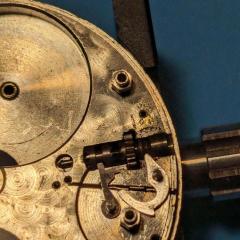Cleaning solution clarification
-
Recently Browsing
- No registered users viewing this page.
-
Topics
-
Posts
-
By SwissSeiko · Posted
Id love to see how he has the output shaft mounted to this setup, as I have the same rotary stage and stepper in my build. -
If you see at least one thread protruding, or even a half, then you may have a chance using this "tool", but don't squeeze hard. Lot's of patience, and if you notice any signs of loctite or other adhesives, then apply several drops of acetone on top of broken stem. Use heat (hair dryer) also. You should be able gradually turn it counterclockwise, just like i did on this broken Timex stem, which was glued with something like nail hardener. Then you can use an extender to save your broken stem. https://m.media-amazon.com/images/I/513DVvkfW5L.__AC_SX300_SY300_QL70_ML2_.jpg You can also try cutting a small grove / slot on top of the broken stem to use 0.7mm flat screwdriver. Depending on the Crown material and Stem material, you can try dissolving the stem.
-
How long had it been without any wind before you first put it on the timegrapher? Perhaps there was some debris / old lubricant that loosened up while you were waiting to do the 24 hour reading? I recently serviced a Seiko 6319 that immediately after service was absolutely horrible on the timegrapher - 24 hours later (without me doing anything) it was rock solid! I was a little surprised by this (as I have seen improvements in amplitude after letting it run in but never a watch going from useless to great!). I was suspicious that some dirt must still be in there so I took it apart and cleaned and lubcricated it again and had exactly the same experience - snow storm that after some hours turned into a nice straigh line with good amplitude 🤷♂️
-
Yes, I know it was able to run before just enough that everything supposed to be affixed with shellac could fall out. I won't get back to work on this watch for several days at least, but one thing you mentioned about the banking pin adjustments being intended for fork horn clearance got me wondering.... The last adjustment I made to the entry stone yesterday did not solve the problem when the balance is installed. The escape teeth can't quite clear the stone when the balance swings. But I thought it was going to work because manually snapping the fork back and forth did allow the escape wheel to advance almost all the time. I wonder if there's another issue with the impulse jewel, that I have to shellac again anyway. I am going to measure the fork slot and the jewel because I am curious if it is the right size or possibly narrower than it should be. My thinking is if the horn clearance is too great maybe it is not getting enough impulse to clear the escape tooth. But pushing the fork with a tool can move it far enough to clear the escape wheel tooth. I'll see later in the week. I didn't expect a big challenge from this watch because it ticked for 5 minutes before stopping without shellac. As always I was way wrong.









Recommended Posts
Join the conversation
You can post now and register later. If you have an account, sign in now to post with your account.
Note: Your post will require moderator approval before it will be visible.